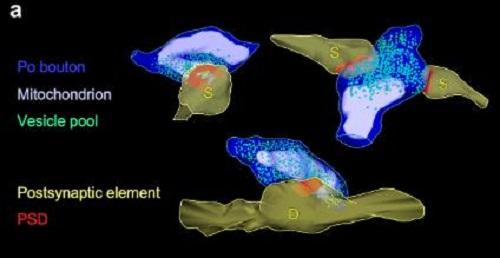
"Orchestra conductor" neurons identified in the functional networks of the brain

2020-03-18
Using advanced 3D electron microscopy techniques and the tagging of individual axons, a team of Spanish researchers has managed to demonstrate significant differences in the structure of the synapses formed by branches of a single thalamic axon in two distant regions of the brain. The study results, which have been published in the Journal of Neuroscience by researchers of Universidad Autónoma de Madrid (UAM), Universidad Politécnica de Madrid (UPM) and Jülich Research Centre (Germany), reveal an unsuspected level of complexity in brain circuits.
Every mental event or voluntary motor act is the result of the simultaneous activity of large groups of neurons in separate areas of the brain located far from each other. How do these nerve cells manage to instantly and selectively coordinate their electrical activity? A paper published in the Journal of Neuroscience sheds new light on the cellular bases behind this process.
The study, which was carried out in mice, focused on the axons connecting the thalamus with the brain cortex and its synapses. The thalamus is a group of neurons located in the center of the brain and acts as a major communications hub between different regions. Axons of thalamic neurons innervate all areas of the cerebral cortex in orderly and selective fashion, forming excitatory synapses mediated by glutamate, a neurotransmitter. Many of these axons generate branches to selectively connect with two or more areas of the cortex.
Using advanced 3D electron microscopy techniques and the tagging of individual axons, researchers were able to measure and compare structures of synapses formed by branches of the same thalamic axon in two distant brain regions.
“Specifically, the study revealed important differences in the intensity and frequency with which synapses can transmit signals, as well as in the type of cells with which the axon connects in each area,” says Francisco Clascá, Professor at the Department of Anatomy, Histology and Neuroscience of Universidad Autónoma de Madrid (UAM), who directed the study.
“In a study published last year—he adds— we had shown that while signals reach both areas at the same time, repetition produces very diverging effects in each area, because transmission is mediated by different types of receptor molecules in different areas”.
That, through its branched axon, a single neuron is capable of producing different effects in separate areas of the cerebral cortex at the same time implies an unsuspected level of complexity in brain circuits.
“These cells could play the role of ‘orchestra conductors’ by selectively and flexibly combining the activity of different neuronal groups in each mental or motor activity—says Francisco Clascá—. Knowing more about these cells is important in modeling the computations performed by the major neuronal networks of the brain and understanding their alteration in brain pathologies,” he concludes.
The study was performed by UAM scientists, in collaboration with researchers at Universidad Politécnica de Madrid (UPM) and Jülich Research Centre (Germany), as part of the EU’s Human Brain Project-European Flagship project.

